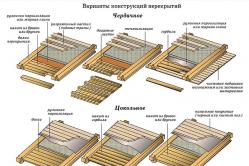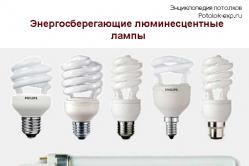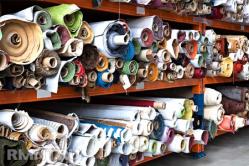Antipyretics for children are prescribed by a pediatrician. But there are situations of emergency care for fever, when the child needs to give the medicine immediately. Then the parents take responsibility and apply antipyretic drugs. What is allowed to give to infants? How can you bring down the temperature in older children? Which medications are the safest?
In the variety of shapes and colors of spotlights it is impossible not to get lost, because first of all the buyer evaluates the external beauty, the combination of the lamp with the interior, and only then thinks about its characteristics, although it should be vice versa. We will tell you which spotlights are best, which ones can be used for specific situations, what to look for, so you will come to the store with full confidence that the choice will fall on the thing you need.
We choose the construction
Point light fixtures are divided into fixed and rotary, but which of them is preferable can not be said unequivocally, because it depends on the room for which they are intended and on your personal preferences. Fixed lamps are those that, once mounted, can no longer move, that is, they illuminate a certain surface. If your project lighting is enough to fully illuminate the entire room or the specified area, then buy fixed instances. Due to the movable part, the rotary lamps are able to rotate through an angle of up to 40 degrees. This kind of luminaires is suitable for living rooms, where you need to direct light on the table or on other parts of the interior, depending on the number of guests and the particular case. However, the performance characteristics of fixed and rotary luminaires are practically the same.
Choose a manufacturer
 Despite the fact that many are wary of the subjects made in China, they can not escape now. However, it is necessary to distinguish really Chinese consumer goods (it costs a penny, which the majority of the population "bites"), and a good quality Chinese product by Europe, that is made for Europe.
Despite the fact that many are wary of the subjects made in China, they can not escape now. However, it is necessary to distinguish really Chinese consumer goods (it costs a penny, which the majority of the population "bites"), and a good quality Chinese product by Europe, that is made for Europe.
A wide selection of lamps are presented to us and Polish manufacturers, but the choice of lamps of our domestic production is much narrower. Fixtures produced in Ukraine and Russia are cheaper than their foreign counterparts, but to find specimens made for halogen lamps, and not for incandescent lamps is much more problematic.
Lamps under incandescent or "halogen" lamps?
If you choose between incandescent lamps and halogen bulbs, thinking what kind of spotlights will look better in the room, you need to understand that the usual lamps we use are not suitable for everyone. Firstly, they heat up quite strongly, and for some types of ceilings (for example, for tension ones) are absolutely not suitable. In addition, the dimensions of the fixtures for fixtures with incandescent lamps are much larger than for halogens - 8-12 cm, so that the ceiling level will decrease significantly.
 Fixtures with halogens are smaller in size, neater look and can be made in any color solutions, which is much more important from the decorative side of the question. In addition, the range of bulbs is huge: with reflectors, with a protective glass, with an open glass. With such lamps, the ceiling will drop only by 3.5-6 cm, which is not too significant. The only drawbacks of lamps with halogen lamps: they are much more expensive than incandescent lamps (although they pay off with interest after a while) and their replacement requires removal of the protective ring before unscrewing the bulb, so this will have to tinker with.
Fixtures with halogens are smaller in size, neater look and can be made in any color solutions, which is much more important from the decorative side of the question. In addition, the range of bulbs is huge: with reflectors, with a protective glass, with an open glass. With such lamps, the ceiling will drop only by 3.5-6 cm, which is not too significant. The only drawbacks of lamps with halogen lamps: they are much more expensive than incandescent lamps (although they pay off with interest after a while) and their replacement requires removal of the protective ring before unscrewing the bulb, so this will have to tinker with.
LED spotlights are the most suitable option for mounting in various surfaces, since they practically do not produce heat, and accordingly, and do not heat the adjacent surfaces. In addition, this type of light source consumes little energy, which does not affect the quality of lighting. On the contrary, lighting devices based on diodes are characterized by the highest level of intensity of luminescence.
For what tasks are used?
LED spotlights today are used as a highlight for objects of different purpose. This can be private housing, a civil, administrative building, as well as a shop, a restaurant, a bar, cafes, billboards and signboards, exhibition halls.
The main purpose of such lighting fixtures is local type lighting. If you want and the availability of funds, you can organize and basic lighting by means of built-in lighting fixtures.
Installations are made on all surfaces: walls, ceilings, even floors. In addition, built-in appliances are often mounted in pieces of furniture, interior. When organizing the public lighting system, such lights are used to illuminate commercial equipment, exhibition boards.
Variants of constructions
Classification of point lighting devices is based on differences in the device:
- rotary;
- irrevocable.
A huge advantage, which distinguishes the built-in performance of the rotary type, is the ability to change the direction of the light flux. Lighting systems using such structures are much more effective. The very same device of this type is easily controlled by turning the inner ring of the mechanism where the lamp is installed.
Built-in lamps are represented by a wide range of models with plafonds of various shapes and configurations. It can be mini-chandeliers, which are the same point devices, only they are equipped with hanging crystal elements. The principle of installation of such versions is similar to that in the case of a conventional recessed luminaire.

The device of a diode fixture
In addition, the separation of lighting devices of this type into groups is also performed on the basis of differences in the methods of installation:
- concealed installation;
- installation with the visible part of the lamp above the surface where it is located.
As a result, a recessed luminaire is recommended to be purchased, based on its own preferences, configuration features and its conformity to the style of the interior. A wide range of models will satisfy any requirements imposed on the appearance and characteristics of devices.
Key Selection Parameters
Spotlights perform two functions: provide a sufficient level of illumination in the room, decorate the room. Accordingly, when choosing the first attention is drawn to the design of the device (the type of materials used, the color of the elements of construction, the shape of the plafond). In addition, the level of brightness, which is characterized by recessed fixtures, is taken into account.
When choosing LED devices, the luminous flux is primarily important, power plays a key role when a suitable power supply model is determined.
If you plan to install lighting equipment in rooms with high humidity, you need to pay attention to the degree of protection of the luminaire. Waterproof models are characterized by class IP54 and above.
Price and quality
Built-in lighting devices based on diodes are represented by a huge number of different types of models, each of which is offered at a certain price. To get acquainted with the assortment of lighting products, it is necessary to know about one important feature of light-emitting diodes: over time they degrade (cloudy), which as a result leads to their complete attenuation.
Today, not all manufacturers use radiators with high quality crystals in luminaires, which contributes to the cost of construction. And it just depends on how long the LED will be characterized by a high luminescence.
At the initial stage, the intensity of illumination will be the same for both more expensive and cheap lighting devices. But only more often in designs that are offered at the most affordable prices, the crystal quickly degrades and very soon it will be necessary to purchase the lamp again. Therefore, it is recommended to choose light sources of proven brands: Cree, Philips, Nichia, Osram.
Calculation of the number of lamps
To decorate the interior, you can use designer recessed lighting devices, but you should also pay attention to the intensity of the glow of each light source, so that the room is not dark or, conversely, too brightly lit.
To this end, a fairly simple calculation of the number of luminaires is carried out:
N = (S * W) / P
where S is the area of the object for which the calculation is performed;
W is the specific power of the light flux (tabular value);
P is the power value of one light source.
There are a number of standard schemes for placing point-type lighting devices on the ceiling:
- in the form of an oval;
- in a circle, in order to increase the brightness of lighting in a room, in such a scheme, a central lighting device is often used;
- half-disposition (two semicircles from opposite sides);
- crosswise installation;
- on the perimeter of the room;
- the arc is centered in the middle of the ceiling structure;
- undulating placement.
Thus, recessed luminaires can be considered an obligatory element of the lighting system, because with their help it is easy to organize basic and local lighting. When choosing such devices, consider the light flux, the degree of protection and design style, power. It is equally important to choose the most appropriate for the particular room layout of the fixtures. This is done taking into account the number of devices and the configuration of the room itself.
Today, a very good option for ceilings are spotlights. They have small dimensions, so that they can be installed on any ceiling surface and at the same time qualitatively illuminate the entire space of the room. To do this, such lamps are placed in a certain way throughout the ceiling.
Spotlights in the house
The most important point of choosing spotlights is their size, which is selected depending on the type of device, as well as the type of ceiling (from gypsum board, suspended or tensioned). It is the size of the spotlights and their selection for a specific type of ceiling will be devoted to this article.
What are they
A spotlight is a small-sized lighting device in which one or more light bulbs (halogen, LED, incandescent lamp) are built in. Thanks to a special design, such devices are now actively used to illuminate a wide variety of rooms. But they got the greatest popularity in home lighting.
These are small devices that have a small angle of light scattering. In this regard, they need to be used not alone, but in groups. In this case, you can place them both at the same distance from each other, so combine them into groups.

Spotlights in the interior of the house
Such lighting devices are used in the house for:
- creation of high-quality lighting in the room;
- decorative ceiling decoration;
Note! Spot lights can have a variety of appearance. Therefore, they will fit perfectly into any interiors.
- visual change of space. For example, using such lamps, you can visually expand the space of the room, as well as zoning it to certain areas.
This kind of lighting installation can be used for various types of ceilings: suspended, tension and drywall. In this case, what type of lamp to choose in each individual case depends on both the overlapping features and the type of the device itself. Therefore, in order to choose not only point light fixtures, but also their sizes, it is necessary to understand their types.
Product range
To date, spotlights for ceilings (tension, hanging and plasterboard) are divided into two types:
- built-in. This is the most common type of point lighting installations. The embedded device will become almost invisible. It will stand out only for its decorative part, and its entire design, including the light source, will be placed inside the ceiling. Depth in this case will hang from the fact that the dimensions will have a built-in light bulb, as well as the type of construction used. Installation here is complicated by the fact that you need a correctly calculated depth, as well as a diameter for embedding in the ceiling surface;
Note! The embedded type of the point plan lamp is often used for creating tension and suspended ceilings (especially from plasterboard).

Embedded Model
- overhead. It has a simple installation, since it is attached to the ceiling surface. In this case, the holes are needed only to mask the wires. In this they are more attractive than the recessed type of luminaire. But they have a clear minus - they stand out prominently above the surface. They are used in situations where it is very difficult or impossible to install the embedded type of the device.

Waypoint model
When choosing a recessed type of luminaire, it is necessary to know also the design features of different models. On this depends what, in the final analysis, will be the depth of embedding.
By design features this type of lighting installation is of the following types:
- rotary. Such lamps can rotate and create a light flux at different angles;

Swivel model
- stationary (non-rotating). They give light that goes exclusively down.
In addition, the dimensions of the device, as well as the depth of embedding of different types (tension, hanging and plasterboard) will depend on the number of light sources. According to this criterion, two groups of point lighting systems are distinguished:
- cardan. In the installation there are several cartridges for screwing bulbs into them (LED, halogen, etc.). Their sizes will be several times larger than those of single ones;
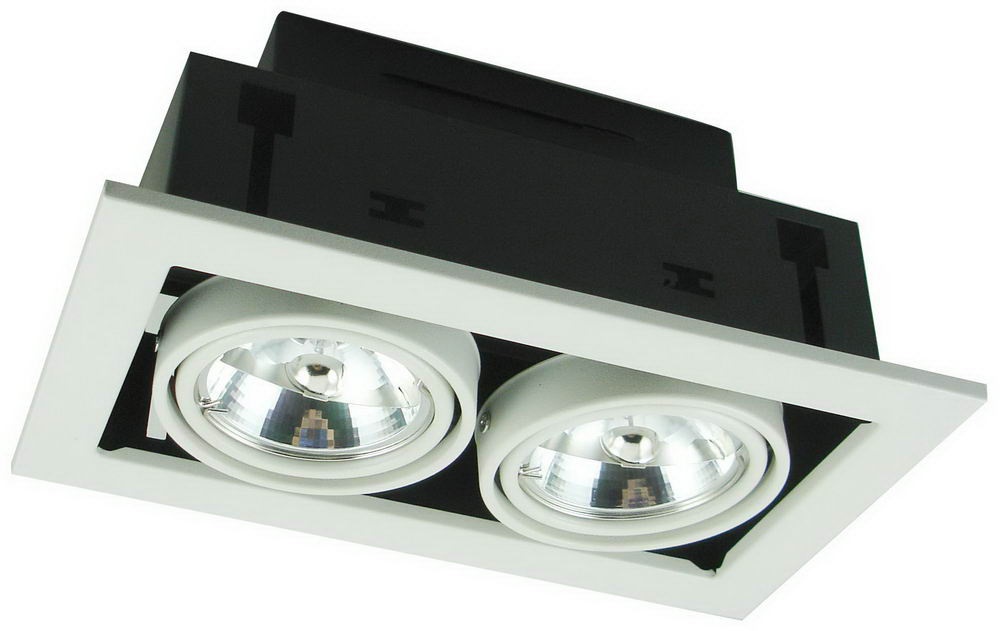
Cardan modification
- single. This is a standard option, in which there is only one light bulb. In this regard, the dimensions here will be minimal.

Single model
It is necessary to know about all types of point lighting devices when the dimensions of the luminaire are important for their installation in the ceiling, as well as the depth of its installation (if the built-in type is used).
Additional aspects of choice
Selecting point lighting products for different types of overlapping (from gypsum board, suspended or tension ones), it is necessary, first of all, to rely on what device has the design of the cartridge. From the type of cartridge will depend on the size of the bulb, which must be screwed into the socket. And the depth to which the device will be placed depends directly on this (if an embedded type is used).

Lamp Holder
Such devices have cartridges:
- E27 - designed for a standard bulb, so it's pretty big;
- E14 is the "minion". Quite small;
- G4, G5, G9 - these bulbs have pins, which allows you to reduce the overall size.
As you can see, the sizes of cartridges have a direct effect on the dimensions of point models.
We sorted out the range of products. Now we will consider what devices should be used in each individual case.
Lighting installations and their dimensions for tension slabs
Stretch ceilings are now very popular.
Note! Stretch ceilings look great in combination with spotlights.

Stretch ceiling with spotlights
When choosing such lighting installations it is necessary to know that for tensioning cloths there are specific requirements for such concepts as depth and dimensions. They are related to the fact that for high-tension fabrics, high temperatures and heating of the surface from the operating light bulb are a particular hazard. And the same requirements are also relevant for plastic floors.
Here you need to consider the following requirements:
- the depth of landing should give rise to a heat from the operating light bulb not higher than 80 degrees;
- the light source should be low-power (not more than 60 W for the fabric, and not more than 40 W for the film). Therefore, it is necessary to give preference to models that have small dimensions both of the shell and of the cartridge with the bulb. The bulbs themselves should have a mirror or black spray;
Note! For tensioning fabrics, the ideal solution will be small LED spotlights.
- the light from the light source must come exclusively from them. Therefore, only rotary models can be used here.

Preparation of ceiling for installation of lighting fixtures
It is important to create the correct holes in the tension web. To create holes here during the preparation of the canvas, you should place the fastening elements in the right places, into which the lamp casings will be placed. It is important to determine the depth of their integration in this situation. After that, he pulls on the canvas. On it, in places of fastenings, decorative rings are established and holes are cut. When forming the holes, the ring will not allow the canvas to tear more than necessary to place the recessed type of luminaire.
Choose the size of the attachment for a tension ceiling
In order not to damage the tension web, suitable models must be selected for mounting. For lighting installations installed in the tension overlap, there are several standard internal diameters: 60, 65, 70, 75, 80, 85 mm. The selection of fasteners is carried out in such a way that they correspond to the size of the inner diameter of the plafond part of the device. The same must be taken into account when creating holes in the ceiling.
In addition, it is necessary to pay attention to the depth of placement of the light bulb. The built-in type of the device can have two variants of the light source placement:
- outer. Here, the bulb is located below the level of the tension web. From it it is separated by a plafond. Such models have smaller dimensions. Also, the depth of their placement will be smaller;

Outdoor version of the light bulb
- interior. The light source is recessed inside the case. Because of this, the depth and the area occupied by the lighting products are also increasing.
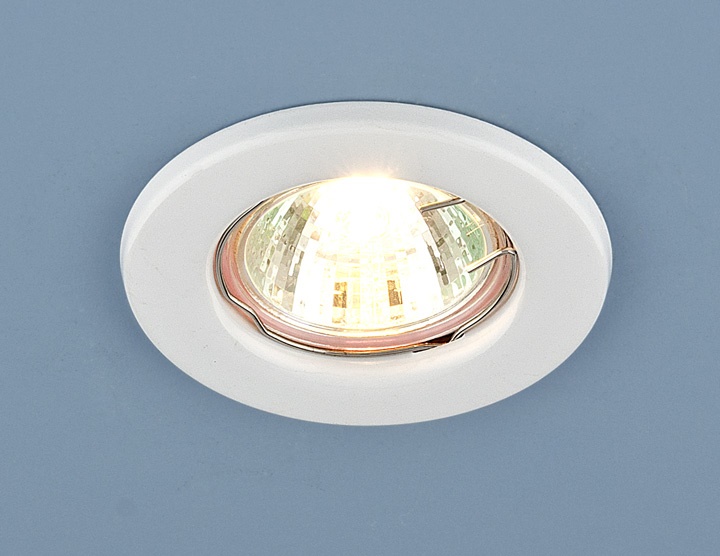
Internal version of the light bulb
When choosing light fixtures for suspended ceilings, just as for suspended and gypsum plasterboard structures, it is necessary to correlate the dimensions of the lighting devices (width, length, depth and diameter) with the dimensions of the room itself. This will allow you to keep the ratio and give the room more harmony.
Dimensions of lighting fixtures for suspended ceilings
For pendant designs, recessed varieties are most often used. Here, both plasterboard and plastic can be used as decoration.
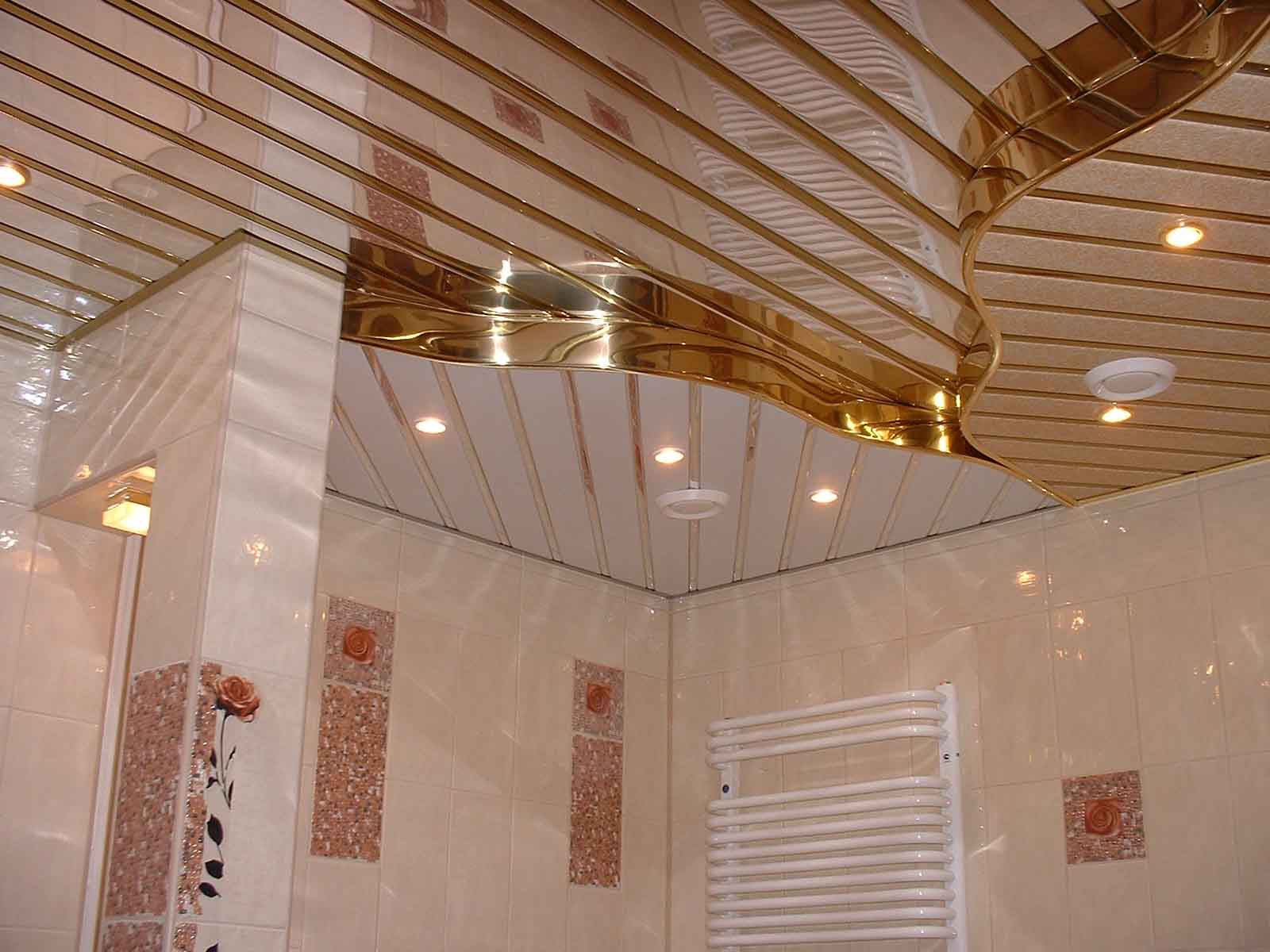
Suspended ceiling in the house
However, there are no such rigid limitations in the selection of lighting installations, as in the case of tension webs. The depth of integration of the device, as well as its magnitude in this situation, will depend on the type of light source. When using incandescent lamps, the luminaire's dimensions will be about 10 cm, and for halogen and LED bulbs - 2-3 times less. You also need to consider the cartridge itself. Specialists do not recommend the use of cartridges of the type E27 and E14 in this situation.
Note! For the suspension structure, the distance to the starting surface can be from 2 to 10 cm.
This variation in depth allows us to use here any models of installations, from the smallest to the largest.
Holes in suspended ceilings are cut using a drill and a special nozzle. In this case, remember that the dimensions of the holes must match the dimensions of the housing. Otherwise, everything can fall out due to a weak fixation in the hole.
Plasterboard ceiling construction and suitable lamps
Gypsum plasterboard ceilings are a variety of suspended structures. Therefore, there are exactly the same conditions for selection. Usually for such designs experts recommend using devices 3-5 cm in height. In this case, it is worth giving preference to LED light sources, which will most effectively illuminate any gypsum board structure.

Spotlights on the plasterboard ceiling
In terms of placement of lighting devices, the following rules exist:
- the maximum distance between instruments should not be more than 120 cm;
- between the point of attachment of the device to the plasterboard and the wall, the distance is not more than 55-60 cm.
On gypsum cardboard overlap, both recessed and overhead models will look equally well, with and without rotary mechanisms. But preference is still given to embedded models, as here all conditions are created for this.
Requirements when choosing LED lights for emergency lighting
Can be made of polished and matte brass, chrome and the like. Choosing a certain lamp , you can stop at one of the various forms and pick up suitable style solution.
Constructively point fixtures are divided into rotary and non-rotating. When choosing, proceed from whether it is important for you to change the direction of lighting or light will fall in a fixed direction.
Dimensions light are largely determined by the type of lamps that are used in them. In the case of conventional incandescent lamps, the size of the luminaire will be about 10 cm, and when using halogen lamps, the dimensions will be two to three times smaller. Consider that the more compact fixtures will cost more.
A spotlight with a conventional incandescent lamp may have open or a closed casing. The casing protects the product from dust and condensation, so it can be used in the bathroom room . When choosing a spot light for a room bathroom should know that there are fixtures with different degrees of protection from moisture.
In lamps with halogen lamps, there is usually a reflector, which performs the function of increasing the brightness. Angle of scatter of the reflector is in the range from 8 to 60 degrees.
If you decide to use point fixtures with halogen lamps rated at 12 V, you will need to install transformers. This is justified, since the service life of such lamps is much larger and they will have to be changed less often.
When choosing a spotlight, also pay attention to its versatility, practicality, quality of workmanship and the absence of visible defects.
Tip 2: How to calculate the number of spotlights
If you want to use spot lights for lighting an apartment or house, you need to think in advance about some of the nuances. The number of fixtures required is one of the first questions that can arise. To solve this problem it is necessary to take into account a lot of factors: the area of the room, the height of the ceilings, the degree of natural light, the presence of other light sources and so on.
You will need
- - Floor plan;
- - Roulette;
- - calculator.
Instructions
Measure the area of the room in which you need to install the fixtures.
Number of lamps per 1 sq. M. m. area depends, first of all, on the power of the lamps. If the lamps in the luminaires have a power of about 35 W, you need to install one luminaire at 1.5 square meters. m. There is a rule, according to which the fixtures are distributed: each 1 square. The area of the square should be illuminated by 20 watts.
If the spotlights are installed as a supplement to the main lighting, for example, a chandelier, you can reduce their number or place in a certain area for lighting.
The minimum distance between the spotlights should be about 30 cm. And from the corner of the wall to the lamp - about 20 cm.
note
In the shops you can find many kinds of spotlights. They differ in the direction of the flow of light and the type of dispersion. There are spotlights equipped with a swing mechanism, thanks to which you can easily adjust the direction of light. You can also find lamps with a lamp located outside. As a rule, they have an external plafond, which makes it possible to increase the dispersion angle of the light flux. Such lamps will require less, since they are able to illuminate a larger area of the room.
Helpful advice
Arrange the fixtures using different options. The most popular method is the arrangement of two or more rows along the perimeter of the ceiling. You can arrange the lamps in the form of a circle.
When lighting a square room, use the design advice and place the spotlights at the corners of an isosceles pentagon.
To evenly illuminate the room, use the chess layout method.
Tips on how to choose a spotlight, how to place lamps on the ceiling. Installation and dismantling of spotlights themselves.
Which spot light to choose
Spot lights are often used in modern interiors for various purposes. When planning to choose a spotlight, consider the functions that it should realize, what kind of lighting it is supposed to perform. There are the following types of lighting:
- The main thing. The light from the lamp spreads throughout the room, evenly illuminating the space. Consider - the larger the room, the more lighting equipment for uniform lighting is required.
- Additional. Added with the presence of the main chandelier, carrying out the main lighting. Several point lighting fixtures are built into the ceiling for the possibility, to supplement at some point a lack of light, or to replace the leading lighting fixture.
- Zoning. Allows you to visually divide the space, for example, create a separate working area, which will be highlighted by a set of spotlights, and an independent place to relax with another light source.
- Accent. Particularly good rotary controlled models (about the types of lamps below). The product will illuminate an interior item, for example, a picture, a photo, a vase, etc. to the taste of the owner.
The choice also depends on the types of luminaires, which are divided into several categories:
By appointment
- Ceiling. Are the main lighting, or part of it (additional or zoning), mounted on the ceiling. It is also possible to use a point-like ceiling light to emphasize an object.
- The wall. Carry a functional value. Often built in near the stairs (in the steps) for security, so that in the dark you can see the outlines of the steps. Used for accent lighting.
- Furniture. They are used for comfort. For example, they are built into the cabinet to facilitate the process of searching or cleaning inside - everything is highlighted.
By type of installation
- Mortise. The interior of the lamp is immersed in a stretch ceiling or wall.
- Overhead. The luminaire (or rather, the mounting bar) is attached to the surface by screws.
By mobility
- Stationary. The head of the lamp does not move, and the light flows in one direction.
- Rotary. The plafond turns, and the owner can change the direction of the light.
By type of lamps used:
- Halogen
- Incandescence
- Luminescent
- LED Light

Which spot light to choose for the ceiling
The choice of a spotlight strongly depends on the ceiling in which it is supposed to be installed.
Concrete. Only overhead luminaires are allowed, since cut-in models are attached to pins. Products stand up crookedly and fall out of concrete (there is nothing to catch on).
Suspension. Specifically, in this article, the features of connecting point light fixtures to the tension ceiling are revealed, since in the 21st century it has acquired particular popularity. With him, there are many questions and nuances.
Stretch. Installed as a mortise, so overhead spotlights. Take into account the depth of the frame, which directly depends on the original type of lamp.
For example, an incandescent lamp requires leaving 100-120 mm of space behind the ceiling, halogen - from 60 mm. Depending on the purpose, it is useful to choose a lamp with a LED lamp (LED). The assortment of the majority of online stores contains dotted LED lights with built-in LEDs - their power is on the average 1W (W). This model is not suitable for general lighting, because it gives a weak light and illuminates the entire room can not.
On the other hand, they are perfect for lighting, for example, a working area in the kitchen for lighting the countertop. On the other hand, if the client wishes, it is possible to replace the type of bulb in most lamps (except for products with built-in LEDs) on the other. For example, with halogen to fluorescent and the like. But it does not affect the depth of the frame, because the depth depends on the base used in the luminaire.
Variants of the arrangement of spotlights in the ceiling
Different interiors use different types of location:
- Figured. Represent some figure, for example, an oval or a square. Often occupy most of the ceiling space.
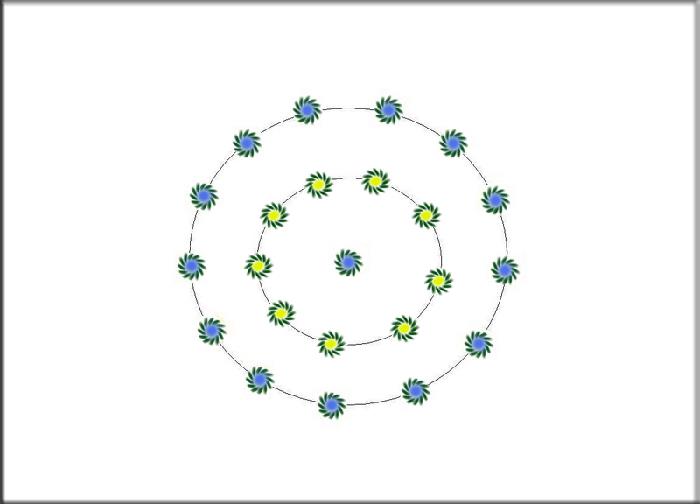
- Linear. Waves, straight lines - parallel or perpendicular (cross) lines, corners. They stretch along the ceiling (in addition to corners that occupy just the corners).
- Wall-mounted. Far from the center, close to the wall in a semicircle, concave / curved wave.

- The starry sky. Systematically or chaotically located point lights, reminiscent of a star-covered sky.
Installation of point ceiling lights, dismantling
Installation depends on the type of luminaire installed on the ceiling. So:
Stretch ceiling design when installing spotlights has its own nuances. In the tension web, cut out a hole corresponding to the diameter of the frame of the point light (indicated in the technical specifications). In the opening itself, in order to fix the web (so as not to spoil and fix the hole), insert the adjusting ring. It is attached to a metal "leg", attached to the concrete self-tapping screws. In gipsokartonnoy design ring is not required - just cut a hole.

To dismantle a spotlight, you need to do the following:
- Disconnect the electric current
- Unscrew / remove the light bulb
- Using a screwdriver, gently pry out the outer edge of the luminaire to form a small gap
- With a second screwdriver, increase the clearance until you can insert fingers into it
- Finger fasten the clips to the body
- Extract the product
If the fastening ring is installed:
- Disconnect current
- Pull out the light source
- Press the ring with your hands
- Pull out the lamp enough to gain access to clothespins
- Press the clothespins and take the product out of the hole
Thinking over the principle of lighting in an apartment, consider different factors. Think about everything - from the type of ceiling construction to the category of lighting and light bulbs that you plan to use.

